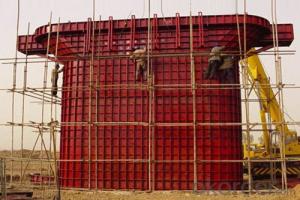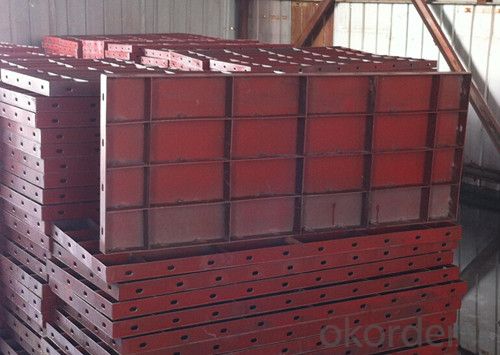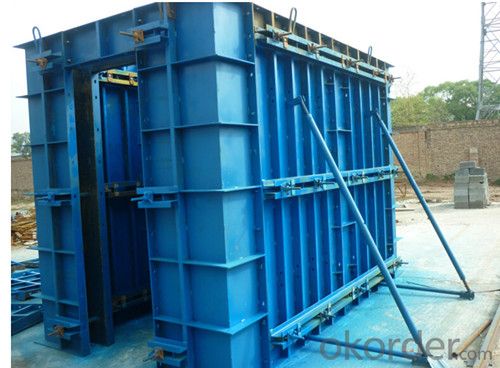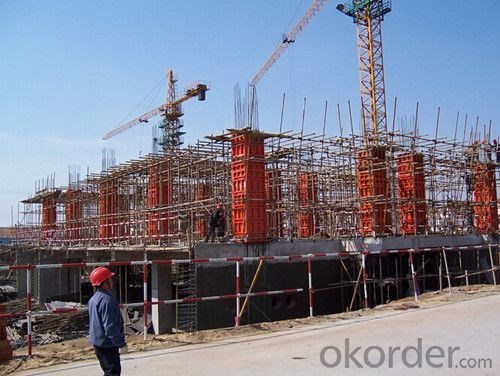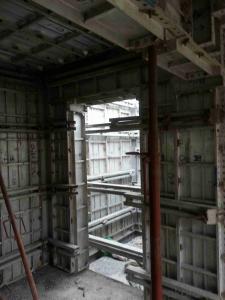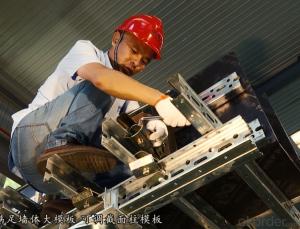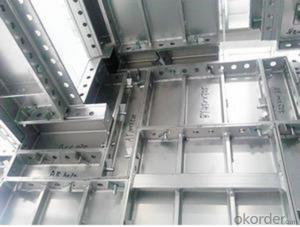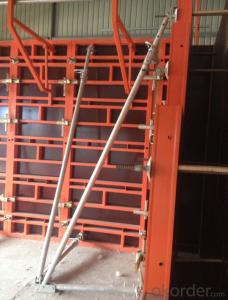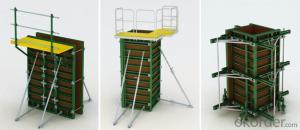Steel Formwork for High Residential Buildings with Recycling
- Loading Port:
- Tianjin
- Payment Terms:
- TT OR LC
- Min Order Qty:
- 200 pc
- Supply Capability:
- 100000 pc/month
OKorder Service Pledge
OKorder Financial Service
You Might Also Like
Introduction for Steel Formwork :
Steel Formwork:used in highway,railway,bridge,tunnel and shearing wall,etc.Our company CNBM which is one of the largest State-Owned Enterprises in China which established in 1984 , has gained the confirmation from the specialist of China Architecture Scence Institute, and has been used by many building operation units and has been highly praised.In 2014, the total turnover volume of CNBM exceeds US$410 billion dollars with a total staff of 180,000. CNBM is listed in the World Top 500 Enterprises !
Characteristic for Wholly Steel Formwork :
1. High Smooth Surface
2. Convex ling for Edge Rib
3. Specialized Connection Pin for Edge Rib Connection
4. High Stiffness for Steel Surface
5. Light Weight for saving producing cost
6. Fast Separate and Easy transport
7. Recycling using
8. Scientific and Reasonable design to meet different working condition
Parameter and Specification :
Code | Size (mm) | Weight (KG) | Code | Size (mm) | Weight (KG) |
P12021 | 1200*2100*55 | 102.96 | P4018 | 400*1800*55 | 28.3 |
P12018 | 1200*1800*55 | 88.4 | P4015 | 400*1500*55 | 23.8 |
P12015 | 1200*1500*55 | 74.15 | P4012 | 400*1200*55 | 19.1 |
P12012 | 1200*1200*55 | 60.11 | P4009 | 400*900*55 | 14.6 |
P10018 | 1000*1800*55 | 76.01 | P4007 | 400*750*55 | 12.3 |
P10015 | 1000*1500*55 | 63.96 | P4006 | 400*600*55 | 9.95 |
P10012 | 1000*1200*55 | 60.11 | P3018 | 300*1800*55 | 20.7 |
P10009 | 1000*900*55 | 39.32 | P3015 | 300*1500*55 | 17.4 |
P9018 | 900*1800*55 | 70.89 | P3012 | 300*1200*55 | 14 |
P9015 | 900*1500*55 | 59.47 | P3009 | 300*900*55 | 10.7 |
P9012 | 900*1200*55 | 48.03 | P3007 | 300*750*55 | 8.8 |
P7518 | 750*1800*55 | 57.8 | P3006 | 300*600*55 | 7.3 |
P7515 | 750*1500*55 | 48.47 | P3004 | 300*400*55 | 5.46 |
P7512 | 750*1200*55 | 39.16 | P2515 | 250*1500*55 | 15.17 |
P7509 | 750*900*55 | 29.85 | P2512 | 250*1200*55 | 12.24 |
P7507 | 750*750*55 | 24.81 | P2509 | 250*900*55 | 9.32 |
P6018 | 600*1800*55 | 43.1 | P2507 | 250*750*55 | 7.71 |
P6015 | 600*1500*55 | 36.3 | P2506 | 250*600*55 | 6.39 |
P6012 | 600*1200*55 | 31.7 | P2015 | 200*1500*55 | 11.6 |
P6009 | 600*900*55 | 23.9 | P2012 | 200*1200*55 | 9.4 |
P6007 | 600*750*55 | 18.55 | P2009 | 200*900*55 | 7.1 |
P6006 | 600*600*55 | 16.25 | P2007 | 200*750*55 | 5.9 |
P5018 | 500*1800*55 | 36.27 | P2006 | 200*600*55 | 6.39 |
P5015 | 500*1500*55 | 30.15 | P2004 | 200*450*55 | 3.64 |
P5012 | 500*1200*55 | 25.55 | P1515 | 150*1500*55 | 9.5 |
P5009 | 500*900*55 | 20.38 | P1506 | 150*600*55 | 4 |
P5007 | 500*750*55 | 15.48 | P1504 | 150*450*55 | 2.98 |
P5006 | 500*600*55 | 13.58 | P1015 | 100*1500*55 | 7.5 |
Code | Size (mm) | Weight (KG) |
P1012 | 100*1200*55 | 6.9 |
P1009 | 100*900*55 | 4.6 |
P1007 | 100*750*55 | 3.8 |
P1006 | 100*600*55 | 3.1 |
P1004 | 100*450*55 | 2.33 |
E1515 | 150*150*1500 | 15.2 |
E1512 | 150*150*1200 | 12.26 |
E1509 | 150*150*900 | 9.34 |
E1507 | 150*150*750 | 7.77 |
E1506 | 150*150*600 | 6.46 |
E1504 | 150*150*450 | 4.87 |
E1015 | 100*150*1500 | 13.13 |
E1012 | 100*150*1200 | 10.61 |
E1009 | 100*150*900 | 8.07 |
E1006 | 100*150*600 | 5.44 |
Y1018 | 100*150*1800 | 14.56 |
Y1015 | 100*150*1500 | 12.29 |
Y1012 | 100*150*1200 | 9.72 |
Y1009 | 100*150*900 | 7.46 |
Y1007 | 100*150*700 | 6.19 |
Y1006 | 100*150*600 | 5.19 |
Y1004 | 100*150*450 | 3.92 |
J0018 | 50*50*1800 | 4.34 |
J0015 | 50*50*1500 | 3.7 |
J0012 | 50*50*1200 | 2.94 |
J0009 | 50*50*900 | 2.3 |
J0007 | 50*50*750 | 1.9 |
J0006 | 50*50*600 | 1.5 |
J0004 | 50*50*450 | 1.13 |
FAQ :
1. Who are we ?
We , CNBM , are a State-Owned Enterprise which established in 1984 , have 32 years experience ,enjoy high reputation .
2. Our Advantage :
Customized products , we have our own R&D department , we can design the drawing and suggest the suitable solution for your project .
3. Our after-Sales Service :
The international Sales Manager and Engineer can go to your job site for work direction and help you deal with your project .
Factory Photos :
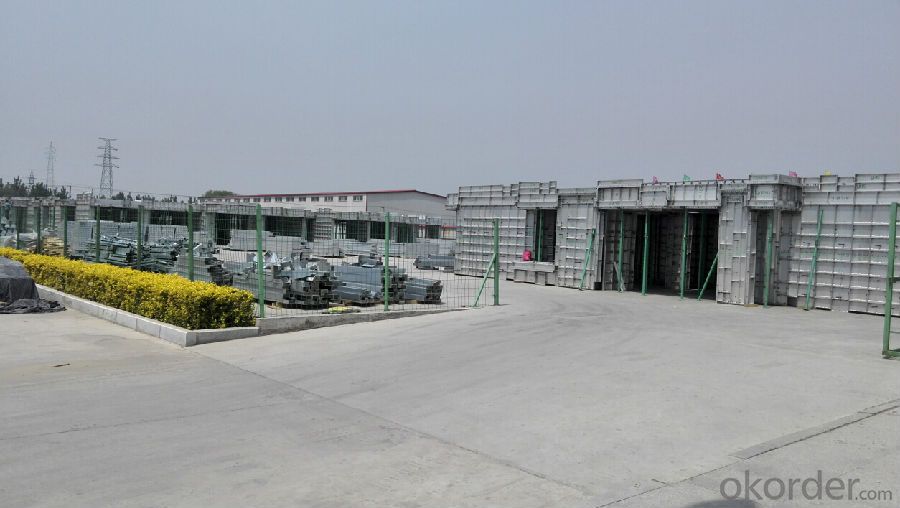
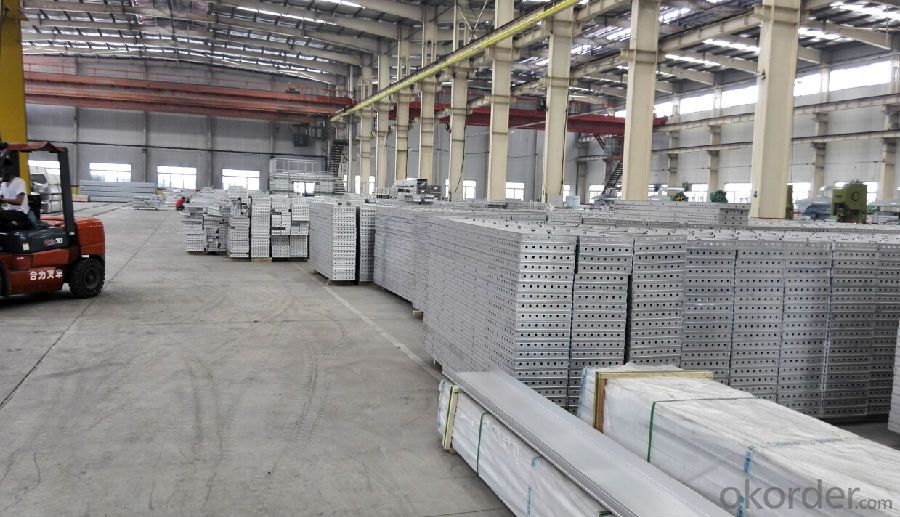
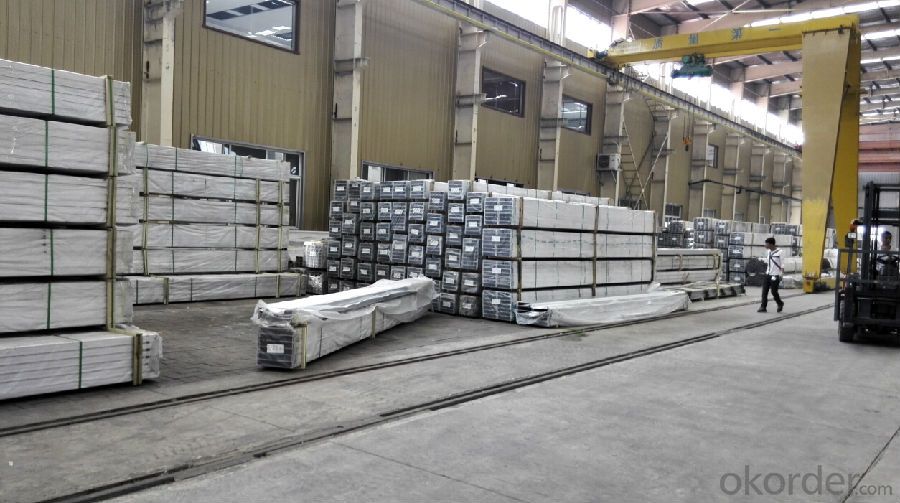
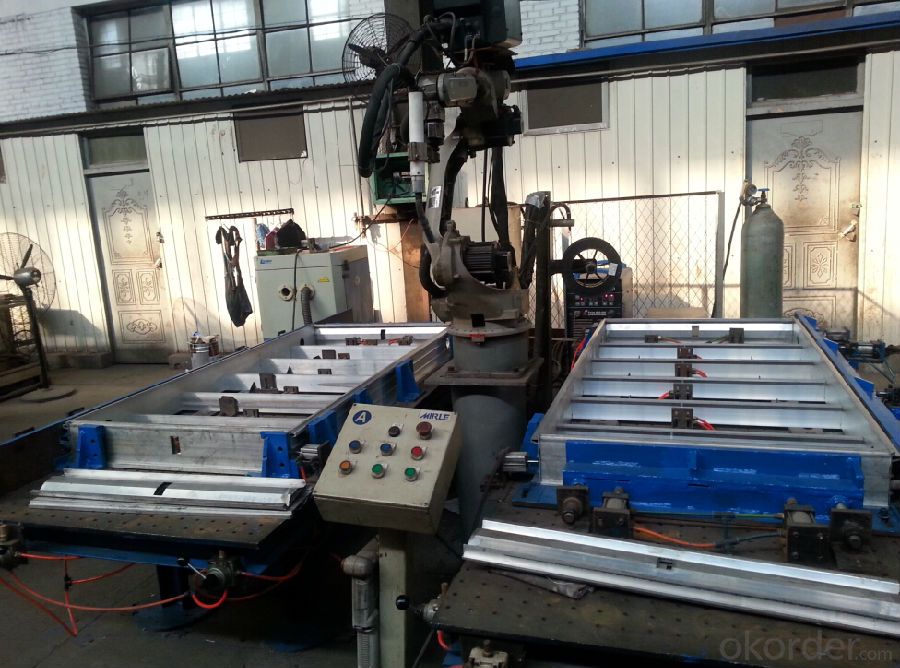
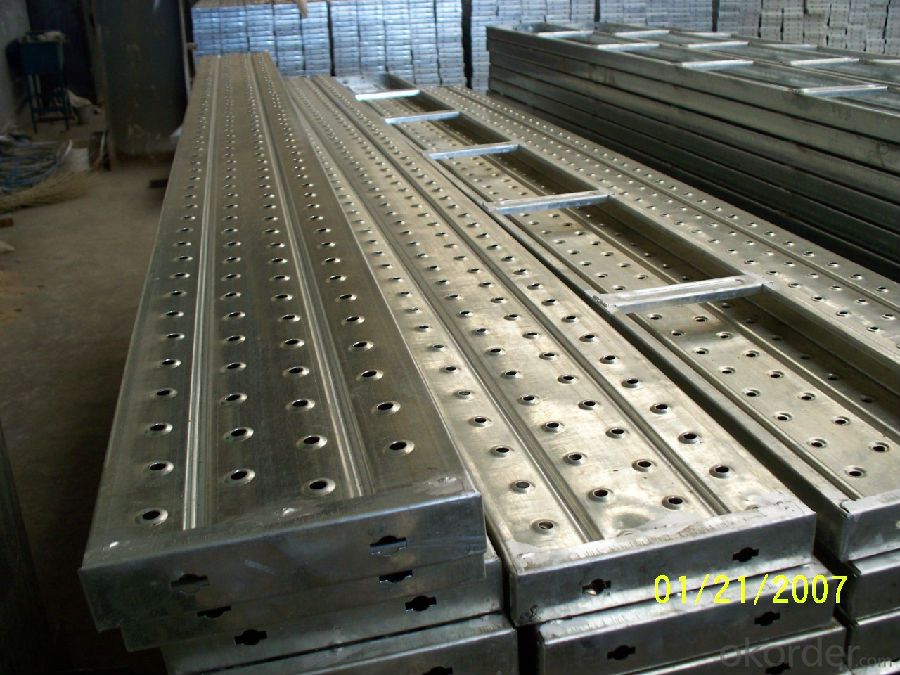
- Q: What are the different locking mechanisms used in steel formwork?
- To ensure stability and integrity in concrete construction projects, various locking mechanisms are employed in steel formwork. These mechanisms are designed to securely fasten the formwork panels together, preventing any shifting or movement that could compromise the accuracy and quality of the final concrete structure. One widely used locking mechanism is the wedge clamp system. This system utilizes steel wedges, which are inserted between the formwork panels and tightened with a hammer or mallet. The wedges establish a robust connection between the panels, firmly anchoring them in place. Another popular locking mechanism is the pin and wedge system. This system involves the insertion of steel pins through holes in the formwork panels. Subsequently, steel wedges are driven into these holes, securing the pins firmly. This creates a stable and secure connection between the panels. Some steel formwork systems also employ a hook and loop mechanism. This entails the attachment of metal hooks to one panel and metal loops to the neighboring panel. The hooks and loops interlock, providing a strong connection between the panels. This mechanism is often favored for its convenience and efficiency, making it a popular choice for specific construction projects. Moreover, certain steel formwork systems combine different locking mechanisms. For instance, a system may incorporate both wedge clamps and pin and wedge systems to enhance stability and strength. Ultimately, the various locking mechanisms employed in steel formwork serve the purpose of ensuring the secure connection of formwork panels throughout the concrete pouring process. Each mechanism offers its own advantages and may be more suitable for specific project requirements.
- Q: How does steel formwork handle concrete pump pressure?
- Steel formwork is highly durable and strong, allowing it to effectively handle concrete pump pressure. Its robust structure and rigidity help distribute and withstand the force exerted by the concrete pump, ensuring that the formwork maintains its shape and integrity during the pouring process. This enables the steel formwork to effectively contain and support the concrete, resulting in a successfully executed construction project.
- Q: How does steel formwork contribute to the overall stability of the structure?
- Steel formwork contributes to the overall stability of a structure by providing a strong and rigid framework for concrete placement. It ensures accurate and consistent shaping of the concrete, preventing any deformations or collapses during the construction process. The steel formwork also enhances the structural integrity of the building by evenly distributing the loads and reinforcing the concrete, thereby improving its strength and durability.
- Q: Can steel formwork be easily dismantled and removed after construction?
- Steel formwork is designed to be easily dismantled and removed after construction, providing a cost-effective and sustainable option for construction projects. It can withstand the weight and pressure of the concrete during the construction process. Once the construction is complete and the concrete has cured, the steel formwork can be dismantled using basic tools like hammers and wrenches. The individual components of the formwork can be unbolted and removed from the concrete structure. After dismantling, the steel formwork can be cleaned, inspected, and stored for future use, reducing the need for new formwork in future construction projects. In conclusion, the use of steel formwork offers the advantage of easy dismantling and removal, contributing to its cost-effectiveness and sustainability in construction projects.
- Q: What are the different types of surface treatments available for steel formwork?
- There are several different types of surface treatments available for steel formwork, each offering its own unique benefits and characteristics. 1. Galvanization: This is a popular surface treatment method where a layer of zinc is applied to the steel formwork. Galvanization helps protect the steel from corrosion, extending its lifespan and enhancing its durability. It can also provide a smoother surface finish. 2. Powder coating: Powder coating involves applying a dry powder to the surface of the steel formwork, which is then heated to create a durable and protective layer. This treatment offers excellent resistance to corrosion, impacts, and chemicals, and is available in a wide range of colors. 3. Painting: Painting is a common surface treatment method where a layer of paint is applied to the steel formwork. This treatment not only provides an aesthetically pleasing finish but also helps protect the steel from corrosion and other environmental factors. 4. Epoxy coating: Epoxy coating involves applying a layer of epoxy resin to the surface of the steel formwork. This treatment offers excellent resistance to corrosion, chemicals, and abrasion. It also provides a smooth and seamless finish, making it easier to clean and maintain. 5. Shot blasting: Shot blasting is a process where steel shots are propelled at high speeds onto the surface of the steel formwork. This treatment helps remove any rust, scale, or contaminants from the surface, resulting in a clean and roughened finish. Shot blasting also improves the adhesion of subsequent surface treatments. 6. Anodizing: Anodizing is typically used for aluminum formwork but can also be applied to steel. This treatment involves creating an oxide layer on the surface of the steel formwork, which enhances its corrosion resistance and improves its appearance. Overall, the choice of surface treatment for steel formwork depends on factors such as the desired level of corrosion resistance, aesthetics, durability, and environmental conditions. Each treatment offers its own set of advantages, and it is important to consider these factors before selecting the most suitable surface treatment for your steel formwork.
- Q: What are the different sizes and dimensions of steel formwork?
- Steel formwork is available in various sizes and dimensions to cater to different construction requirements and project needs. The most common sizes of steel formwork panels are typically 2 meters (6.5 feet) in height and 1 meter (3.2 feet) in width. However, these dimensions can vary depending on the manufacturer and the specific project requirements. In terms of thickness, steel formwork panels are usually between 12 to 14 millimeters (0.5 to 0.6 inches) thick. This thickness ensures the panels are sturdy enough to withstand the pressure exerted by the concrete during the pouring and curing process. Additionally, steel formwork panels are available in various lengths to accommodate different wall heights and dimensions. These lengths can range from 1 meter (3.2 feet) to 4 meters (13.1 feet) or even longer, depending on the project requirements. Apart from panels, steel formwork systems also include other components such as beams, props, adjustable struts, and connectors. These components come in different sizes and dimensions to support the formwork structure and ensure stability and safety during the construction process. It is important to note that the dimensions and sizes of steel formwork can vary depending on the manufacturer, project specifications, and regional construction practices. Therefore, it is crucial to consult with the manufacturer or a structural engineer to determine the appropriate sizes and dimensions of steel formwork required for a specific construction project.
- Q: How does steel formwork handle different concrete jointing techniques?
- Steel formwork is a versatile and robust material that can easily handle different concrete jointing techniques. Whether it is used for traditional jointing methods like keyways, tongue and groove, or dowels, or for more advanced techniques like construction joints, expansion joints, or control joints, steel formwork provides the necessary strength and stability to ensure the jointing process is successful. Its durability allows it to withstand the pressure and forces exerted during the concrete pouring and curing stages, ensuring that the joints remain intact and the structure maintains its integrity. Additionally, steel formwork can be easily customized and adjusted to accommodate various jointing requirements, making it a reliable choice in construction projects.
- Q: What are the common design considerations for steel formwork in high-rise buildings?
- When it comes to designing steel formwork for high-rise buildings, there are several common considerations that need to be taken into account. These considerations are crucial for ensuring the structural integrity, safety, and efficiency of the formwork system. 1. Load capacity: Steel formwork needs to be able to withstand the loads it will be subjected to during the construction process. This includes the weight of the concrete, workers, equipment, and any other imposed loads. The formwork should be designed to have sufficient load capacity to prevent any deformation or failure. 2. Stability: High-rise buildings are subjected to various external forces such as wind and seismic loads. The formwork system needs to be stable and resistant to these forces to prevent any accidents or collapse. Proper bracing, tie-downs, and anchorage systems should be incorporated into the design to ensure stability. 3. Durability: Steel formwork must be able to withstand the harsh conditions of construction sites, including exposure to moisture, chemicals, and physical impact. The material selection and protective coatings should be chosen carefully to ensure long-term durability and prevent corrosion. 4. Flexibility: High-rise buildings often have complex geometries with different floor layouts, wall configurations, and column sizes. The formwork system should be flexible enough to accommodate these variations and allow for easy adjustments and reusability. Modular formwork systems are commonly used to provide this flexibility. 5. Safety: Safety is of utmost importance in high-rise construction. The design of the formwork system should incorporate safety features such as non-slip surfaces, guardrails, access platforms, and fall protection systems. Adequate space for workers to move around and perform their tasks safely should also be considered. 6. Construction timeline: Time is a critical factor in high-rise construction projects. The formwork system should be designed to enable fast and efficient construction, minimizing downtime and delays. This could involve using pre-fabricated components, easy assembly and disassembly methods, and efficient material handling systems. 7. Cost-effectiveness: The design of the steel formwork system should optimize cost-effectiveness without compromising on quality and safety. This includes factors such as material selection, formwork reuse, efficient use of labor, and minimizing waste. Overall, the design considerations for steel formwork in high-rise buildings revolve around load capacity, stability, durability, flexibility, safety, construction timeline, and cost-effectiveness. By carefully addressing these considerations, designers can ensure a successful and efficient construction process for high-rise buildings.
- Q: What are the common types of form ties used with steel formwork?
- There are several common types of form ties used with steel formwork. These ties are essential for holding the formwork together and ensuring the stability and strength of the concrete structure. 1. Snap Ties: Snap ties are the most common type of form ties used in steel formwork. They consist of a metal rod with cones or flat disks on each end. The ties are inserted through holes in the formwork panels and secured in place by a wedge or a pin. Snap ties are easy to install and remove, making them a popular choice for formwork construction. 2. Flat Ties: Flat ties are similar to snap ties but have a flat plate on one end instead of a cone. The flat plate provides a larger surface area for load distribution, making these ties suitable for heavy-duty applications. Flat ties are commonly used in large-scale construction projects where high strength and stability are required. 3. Waler Ties: Waler ties are used to connect the formwork panels to walers, which are horizontal beams that support the formwork. These ties are typically made of steel bars or rods and are secured to the formwork panels by bolts or clamps. Waler ties help distribute the load evenly across the formwork system and provide additional support and stability. 4. Coil Ties: Coil ties are flexible ties made of wire coils. They are used to secure two opposite formwork panels together. The coil ties are inserted into the formwork panels and twisted at both ends to secure them in place. Coil ties are cost-effective and easy to use, making them a popular choice for small-scale construction projects. 5. Cone Ties: Cone ties are similar to snap ties but have a cone-shaped end on one side. The cone-shaped end allows for easy insertion and removal of the tie. Cone ties are typically used in situations where frequent formwork assembly and disassembly is required, such as in the construction of temporary structures or formwork systems used in precast concrete production. These are some of the common types of form ties used with steel formwork. The choice of tie depends on factors such as the size and complexity of the project, the required strength and stability, and the ease of installation and removal. It is important to select the appropriate form ties to ensure the safety and efficiency of the formwork system.
- Q: Can steel formwork be used in architectural concrete projects?
- Yes, steel formwork can be used in architectural concrete projects. Steel formwork is a common choice for many construction projects, including architectural concrete, due to its durability, strength, and versatility. Steel formwork provides excellent support and stability to the concrete structure, ensuring that it maintains its desired shape and form during the pouring and curing process. Additionally, steel formwork is highly resistant to warping or bending under the weight and pressure of the concrete, which is crucial for achieving accurate and precise architectural designs. Steel formwork also allows for easy assembly and dismantling, making it a cost-effective option for architectural concrete projects. Overall, steel formwork is a reliable and efficient choice for architects and builders looking to create intricate and aesthetically pleasing concrete structures.
Send your message to us
Steel Formwork for High Residential Buildings with Recycling
- Loading Port:
- Tianjin
- Payment Terms:
- TT OR LC
- Min Order Qty:
- 200 pc
- Supply Capability:
- 100000 pc/month
OKorder Service Pledge
OKorder Financial Service
Similar products
Hot products
Hot Searches
Related keywords
